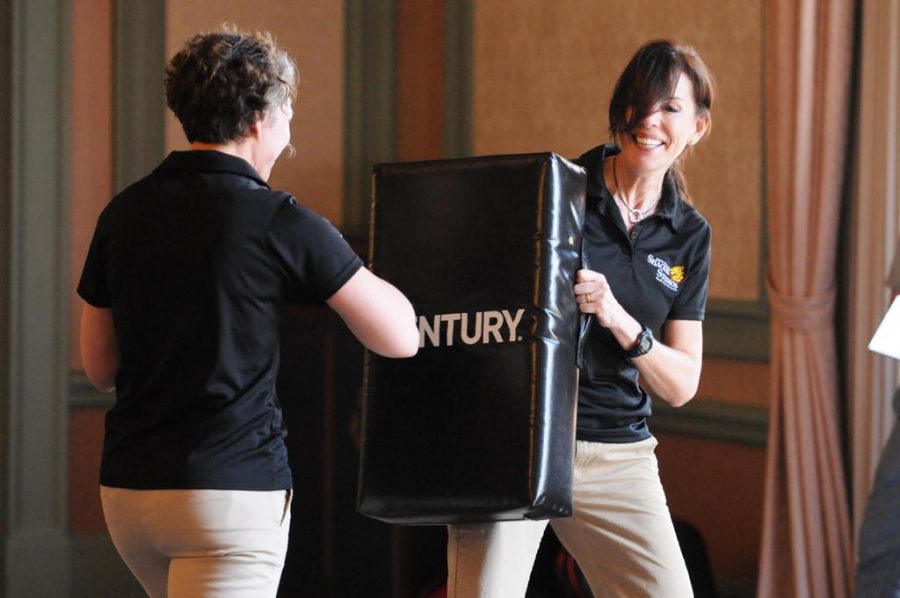About three years ago, John Kandray, his boyfriend and their friends were eating and drinking at the Little Italy Days Heritage Festival in Bloomfield when another group of men began making anti-gay slurs about them.
“I had no idea what to do,” he said.
The situation didn’t escalate beyond the insults, Kandray said, but it still made him feel helpless.
Soon after, Kandray, now an assistant trainer, took up kung fu and other forms of self-defense as a way to protect himself and his loved ones. On Sunday, he shared his training with Pitt students as part of the first formal defense session Pitt’s Rainbow Alliance hosted for students. Three students from Rainbow Alliance sparred with three martial arts instructors in the William Pitt Union’s Kurtzman room for about three hours.
Instructors from Steve DeMasco’s Shaolin Studios, a kung fu studio in Regent Square — taught the self-defense session. The session was one of a growing number of outreach classes the Shaolin Studios’ instructors are conducting in the city to train marginalized groups. Sunday’s session was part of a partnership between Rainbow Alliance and Shaolin Studios that Rainbow president Marcus Robinson said the club hopes to expand in the coming year so more members of the club can attend.
Noting recent attacks on members of the LGBTQ+ community, Kandray said self-defense training is important for both protection and confidence.
“Our rights and well-being are challenged and we’re being told we’re less than and that we’re not worth defending,” Kandray, who trains at the Shaolin Studios, said. “We want to cut that down to nothing.”
According to FBI data from 2014, more than 20 percent of hate crimes that year, or about 1,114 cases out of 5,462, were directed at members of the LGBTQ+ community.
The instructors at Shaolin currently pair with groups like fraternities and sororities, the Pitt police and now the Rainbow Alliance, to teach self-defense classes at Pitt. Sunday’s session covered basic tenets of self-defense, including awareness and intuition, body language and eye contact and basic kicks and punches.
Because he’s trained in tae kwon do for eight years and knows the importance of self-defense, Peter Crouch, the incoming president of Rainbow and current business manager, said he had wanted the club to host this kind of program since the beginning of the school year.
According to Lisa Nakamura, a sixth-degree black belt in Shaolin Kung Fu, who runs Shaolin Studios with her husband, the first step to self-defense is as simple as paying attention.
“It’s listening to that inner voice that says, ‘Something isn’t right,’” Nakamura, who led the training session on Sunday, said. “I think we tend to squash that voice.”
Especially when walking alone at night, Nakamura said she recommends not talking on the phone or texting while moving and avoiding listening to music through earbuds.
“I think we get into a mode we think, ‘If I can’t see other people, they can’t me,’ but we don’t have that superpower,” Nakamura said.
Though Nakamura was preparing the students for a worst-case scenario, she said the self-defense skills showed how important it was to be conscious of one’s surroundings.
“I’m not trying to teach you to have a chronic sense of fear, I’m trying to teach you to have a healthy sense of awareness,” Nakamura said.
If an assailant approaches, Nakamura said, the next step to staying safe is to communicate a strong message through body language and eye contact.
When it was his turn to practice, Crouch stood his ground, stared down instructor Michele Colvard and yelled, “No,” making it clear that if Colvard were to attack, he would be ready.
Colvard, who had come up behind Crouch for a potential attack, was taken aback. With his feet firmly squared toward Colvard, Crouch maintained stern eye contact and braced himself with fists raised.
“If you’re starting to get that feeling — that the creep-o-meter starts going off — you want to give yourself a buffer,” Nakamura said.
As the other two students and instructors followed suit, Nakamura showed everyone how a stance that showed a person was ready to attack if necessary and a stern “no” or “stop” would tell any potential attackers to back off.
“We’re a community that doesn’t always feel safe walking home at night,” Crouch said. “I think making people feel safe is important.”
Finally, as a last resort, Nakamura taught the students to throw their elbows, hit with their palms and kick an assailant’s knees and shins in order to escape an attack. These attacks hit the “big nerve centers” of the body, Nakamura said, which makes it more likely for a person defending themselves to overcome the flood of adrenaline in their bloodstream. Many people forget the fourth step in self-defense, Nakamura said, which is calling the police, seeking medical attention or getting some other form of help.
After the formal training, Nakamura taught the students how to turn everyday items — like textbooks, coffee mugs and keys — into blunt weapons they could use to hit an attacker.
“We’re just buying you time to get out of there, that’s why it’s self-defense,” Nakamura said. “We’re just buying you time so you can go get help.”


